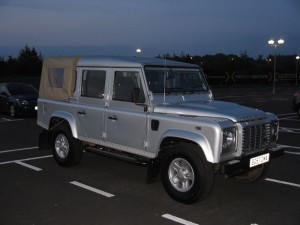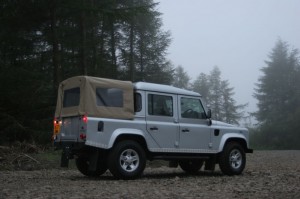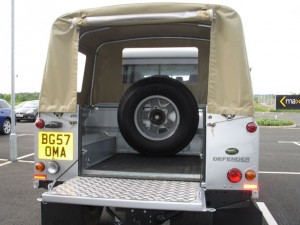Defender of the Faith …
 Here’s an amazing fact. Over three quarters of the vehicles produced by Land Rover during its fifty year history are still in existence! Just think, if every vehicle manufacturer claimed the same staying power, there would be no room for us humans! Our editor hopes this model longevity will rub off on him!
Here’s an amazing fact. Over three quarters of the vehicles produced by Land Rover during its fifty year history are still in existence! Just think, if every vehicle manufacturer claimed the same staying power, there would be no room for us humans! Our editor hopes this model longevity will rub off on him!
You can take a Land Rover out of the countryside, but you can’t take the countryside out of Land Rover. Despite the rate of automotive advances over the past 100 years and compared to NASA’s ‘Robot Rover’ on Mars, the Land Rover Defender appears to have more in common with Fred Flintstone’s personal transport. This is not a lifestyle machine, this is a no-nonsense, functional utility vehicle.
And yet, there are still some eedjits out there for whom the Land Rover Defender is the ultimate and only vehicle of choice. They live, breathe, work and play Land Rover, but once you spend some serious time in one of these machines in its natural habitat then you begin to get some sense and understanding of the passion that these machines inspire in those who just love mechanical objects.
But for the vast majority of us, it’s a no-compromise working machine and therefore not ideal as a general everyday runabout. No, this is a just another tool for the working man or the working fleet. The vehicle of choice for gamekeepers, farmers, electric pylon inspectors, radio mast erectors and site drilling personnel, the Land Rover is also good for less dramatic duties, attending breakdowns, carrying tools and personnel to remote places, or pulling trailers – and rally cars out of ditches!
Although there is now a double cab version of the Defender one tonne pick-up, don’t confuse this with the Ford, Mitsubishi, Nissan, Toyota or Mazda versions. It might have the fancy alloy wheels and checkerplate trim decoration to compete with these lifestyle vehicles, but it doesn’t have the same interior room or on-tarmac manners of the others.
Put it this way, if pickups were a breakfast cereal, then the Land Rover would be a big bowl of warm and welcoming, lumpy porridge compared to its sugar-coated, sun-kissed, golden flaked corny rivals. This vehicle has the stamina and energy to do the jobs and reach the places that the others simply can’t.
But there are drawbacks. In such a no-compromise vehicle it is inevitable. It has been said that a Land Rover driver can be spotted in a crowd by the way he walks – with a list, walking with the right shoulder higher than the left. This is due, not to leaning into the wind while tramping across exposed hillsides, but because of the driving position that has to be adopted, hunched up in the driver’s seat with the right arm draped over the top of the steering wheel and the left arm pushing and pulling to change direction.
In-cab Comfort?
 To say that the cabin is cramped is an understatement. I for one would chuck out the central console storage box between the two front seats to create a bit more room as the left buttock is squashed tight against this box and the right buttock is jammed up against the door. Even wearing an extra set of winter woollies can make the difference between fitting in and ‘no chance’.
To say that the cabin is cramped is an understatement. I for one would chuck out the central console storage box between the two front seats to create a bit more room as the left buttock is squashed tight against this box and the right buttock is jammed up against the door. Even wearing an extra set of winter woollies can make the difference between fitting in and ‘no chance’.
In fact, there is a consensus of opinion that seat belts in the Defender are superfluous. The occupants are squeezed in so tightly and the windows are so small, that being ejected from the vehicle in the event of a crash is impossible!
Having said that, one radical advance instantly noticeable on the modern Defender is electric windows. This represents a great improvement on the previous side-ways sliding half window which allowed the driver to mercifully poke his right elbow out of the window thereby creating a little more elbow room inside the cab. But even that was limited because of the half window.
And electric windows are an essential, not a luxury. For if fitted with window winders, there is no way that the driver can ease his right arm down between his body and the door to reach such an item. Even reaching the door handle is an exercise in dexterity.
And yet for all its cramped interior, once installed, most other controls are perfectly within reach and functional. There is plenty of room for feet clad in working boots in the pedal area and if the driver adopts the appropriate ‘lean to the left’, then perhaps this cramped position does have one side benefit. When the going gets rough, it stops the driver lolloping about from side to side and jerking against the seat belts. In fact, at slow speeds over rough ground, it is almost comfortably acceptable. I said almost!
There are three seats in the rear, but like the front, the upright, knees-up seating positions are not ideal for prolonged journeys. However, the double cab version of the Defender is infinitely less claustrophobic than the standard pickup cab.
But if claustrophobia is still a problem, then the Defender still as those under-windscreen vents which open outwards above the bonnet, much as the original versions did fifty years ago. Other foibles reminiscent of the old models are noisy windscreen motors and heater blowers, perhaps not so much noisy as just not sound-deadened. But with everything switched on inside the cab, the radio controls need to be well wound up to break through with weather reports!
Loadspace
 If you want to carry large objects, forget it. The loadbay in the rear is quite small with barely more than a metre floor length between the tailgate and the backside of the cab, although there is a long wheelbase version of the Defender double cab with a 1.6 metre floor length.
If you want to carry large objects, forget it. The loadbay in the rear is quite small with barely more than a metre floor length between the tailgate and the backside of the cab, although there is a long wheelbase version of the Defender double cab with a 1.6 metre floor length.
Otherwise, what you have is a very small boxy area almost a metre and half wide at its widest, but less than a metre wide between the ‘wheel boxes’ with the spare wheel bolted to the back of the cab further encroaching on space, although that could be removed to the bonnet top with the appropriate wheel mounting kit.
There is a choice of canvas hood or hardtop (a £1750 extra!) for some additional protection from the elements if carrying dogs or expensive tools.
If you want to carry bigger loads, then you’ll need a trailer and the Defender is rated for 750 kg unbraked trailer load but an impressive three and half tonnes with over-run brakes fitted and 4 tonnes with coupled braking.
There is just one complaint and that concerns night driving. Although it’s not a fast vehicle by any means it could still benefit from a decent set of headlights. On main beam the range is barely adequate for 70 mph and if you do go off road across the field or up a farm track with no cats eyes then a broader and brighter dipped beam would be much appreciated. Considering the wide choice of additional lighting options, this is obviously something that Land Rover is aware of, but perhaps there is a bigger profit element in additional spotlights than fitting fancy reflector units to the headlamps! Or is that just me being too cynical for my own good?
On and Off Road
If awkward on tarmac, the Defender is in its element off road. The high geared steering becomes a much more accurate directional aid than it is on tarmac where it has all the finesse of a canal barge tiller. The gearbox doesn’t need to be rushed when off road and therefore selecting gears becomes a more considered appraisal of the challenges ahead, which results in more relaxed changes and a more leisurely pace.
For most conditions, standard four wheel drive is adequate. The 2.5 litre TD5 engine clatters happily under the bonnet and dispenses with the need for a rev counter in the dashboard. That’s not to say it’s noisy, but the engine note can be heard quite distinctly so that you know exactly how hard it is working.
Accessing the five lower ratios through the two speed transfer box can actually be done on the move, at modest speeds, whereas in the past, the vehicle would have to be stopped to engage, but it’s only when the going gets really sticky will this be required. The four wheel drive system is constant and pretty basic lacking many of the optional, electronic aids and gizmos that are featured on its more glamorous Freelander, Discovery and Range Rover siblings, but it is all the better for it, leaving the driver to figure out how to get stuck and how to get out of it.
With a mighty impressive 300 Nm of torque (221 lbs/ft) there is very little that will stop the Defender and although it almost matches the approach angle (50 degrees) of its short wheelbase counterpart (48 degrees), it loses out quite sharply on departure angles (49 degrees compared to 34.30 degrees) because of the extended overhang. According to Land Rover it will wade through 500 mm of water (or mud) although personally I have driven through deeper water in a fast flowing river (with Land Rover personnel on hand!) without any ill effects and as far as going uphill is concerned (45 degree maximum is claimed), the driver will more often chicken out before the Land Rover does.
The same engine will transport the vehicle at up to 70 mph on the road (it will go faster, but the engine doesn’t sound too happy above that), but it takes on an entirely different character at mud-plugging, walking-pace off road. You get the feeling that on tickover in second gear it will conquer the world climbing over anything that gets in its way.
On the basis of ‘why change it, because it works and works well’ the Defender still has live beam axles front and rear, suspended from coil springs and hydraulic dampers, unlike some of its fancy independently sprung brethren. It’s a much more simple system, and I would venture to suggest more rugged and robust, and yet it still delivers impressive wheel articulation for scrambling, at an angle, across moorland drainage ditches, which might defy anything other than tracked vehicles.
Accessories and extras
Browsing the long list of accessories for a Land Rover is an enjoyable experience in its own right as you start to visualise the vehicle you could build. Apart from the safety options like ABS and the cosmetic additions like rear steps, siderunners, and smoked sidelight lenses there is a huge array of technical equipment.
Besides the full range of tow ball and tow jaw options, with or without drop plate, front and rear winches and power take-off systems, there is a choice of roof racks and ladders, auxiliary lighting bars and worklights, split charging systems and raised air intakes, and where else would you find such an option as a flag mast!?
The only trouble is, you could almost double the price of the vehicle just tarting it up!
Conclusions
This is not so much a second vehicle for the two car family, this is more of a third vehicle to be used only when necessary or for serious fun. As a workhorse it is almost unmatched, but as a lifestyle vehicle it is only for the ‘mechanically disturbed’ or the dedicated mud-plugger. I loved driving it, but I couldn’t live with it.